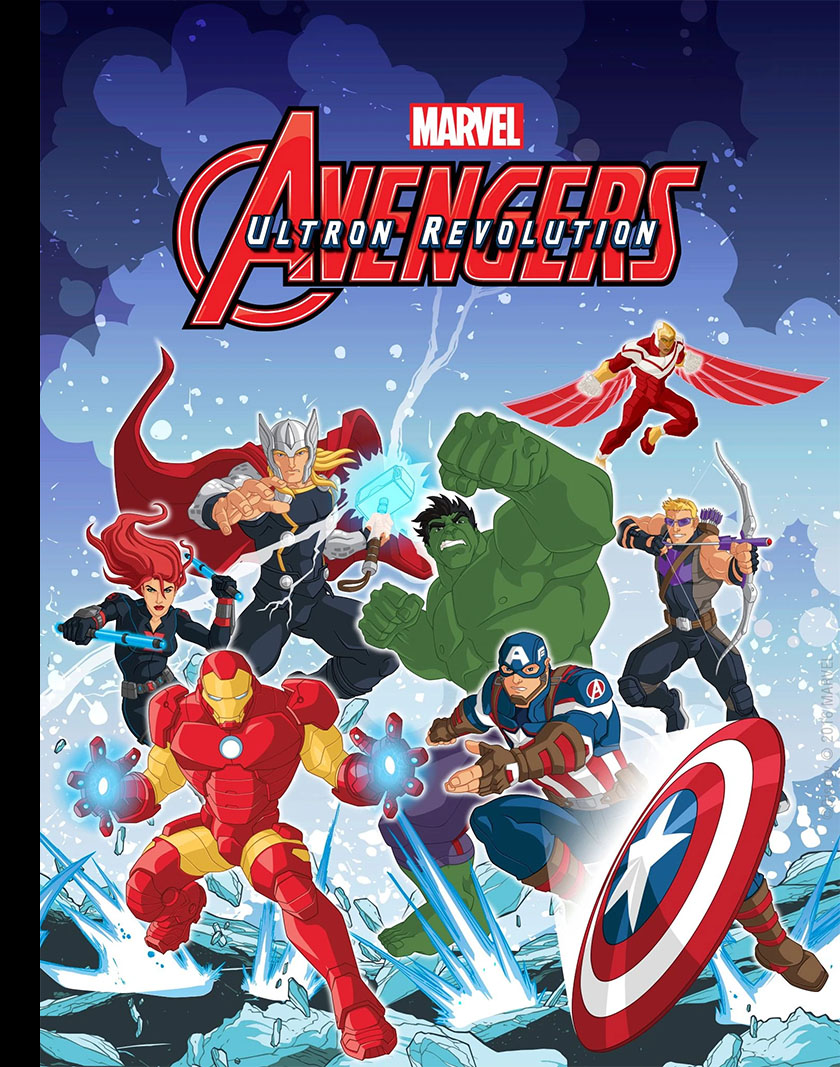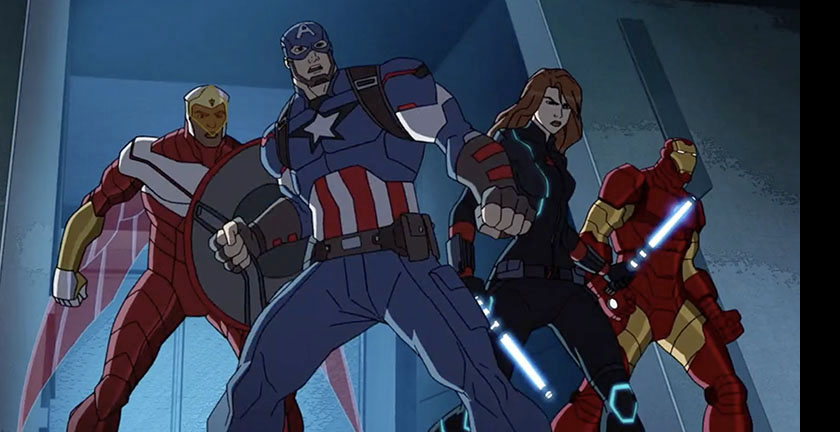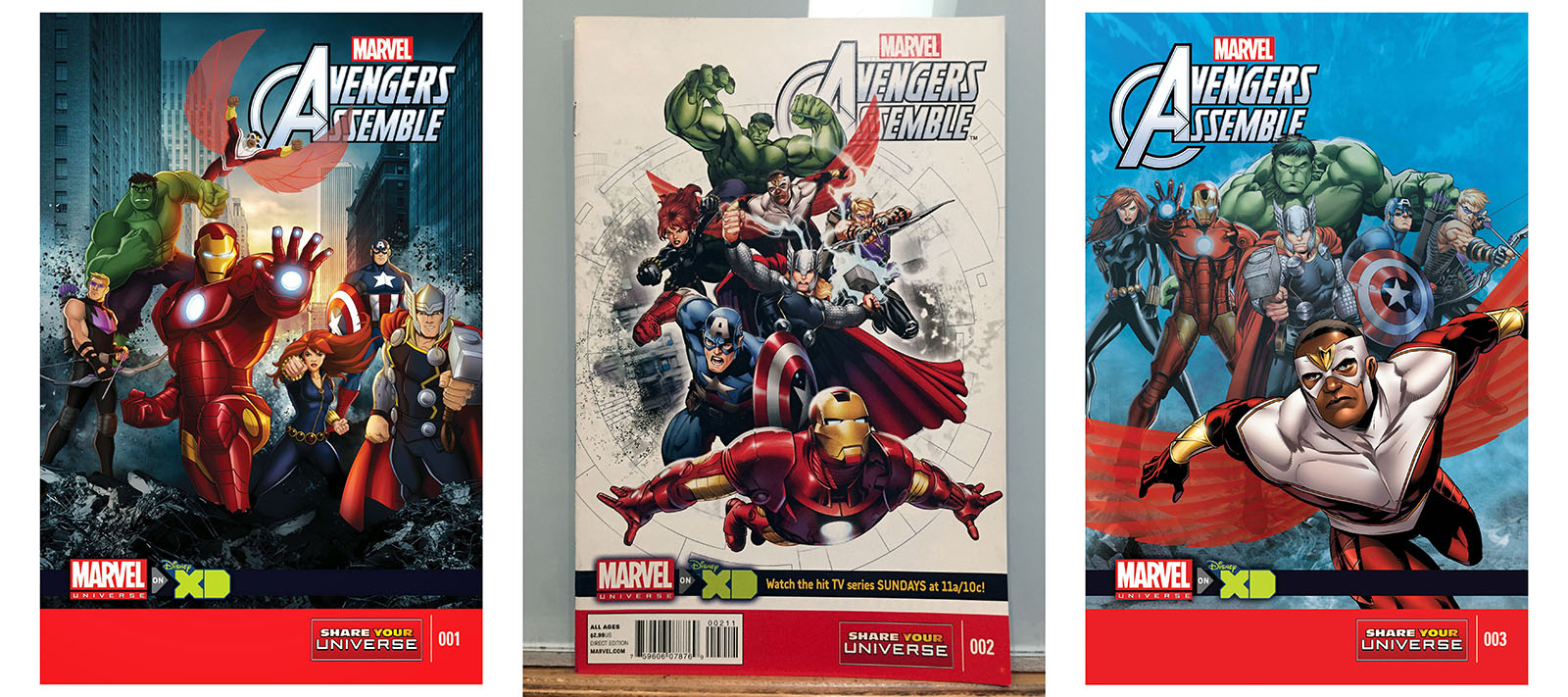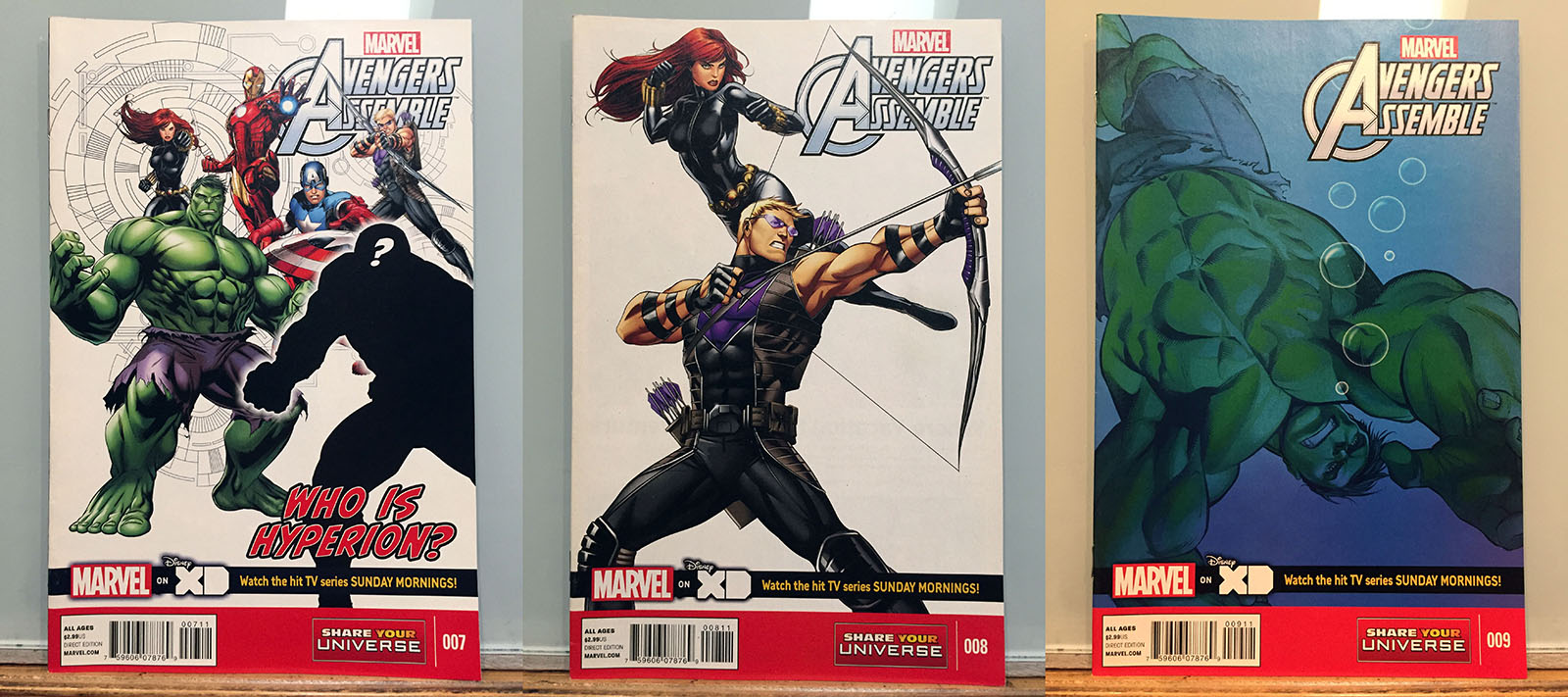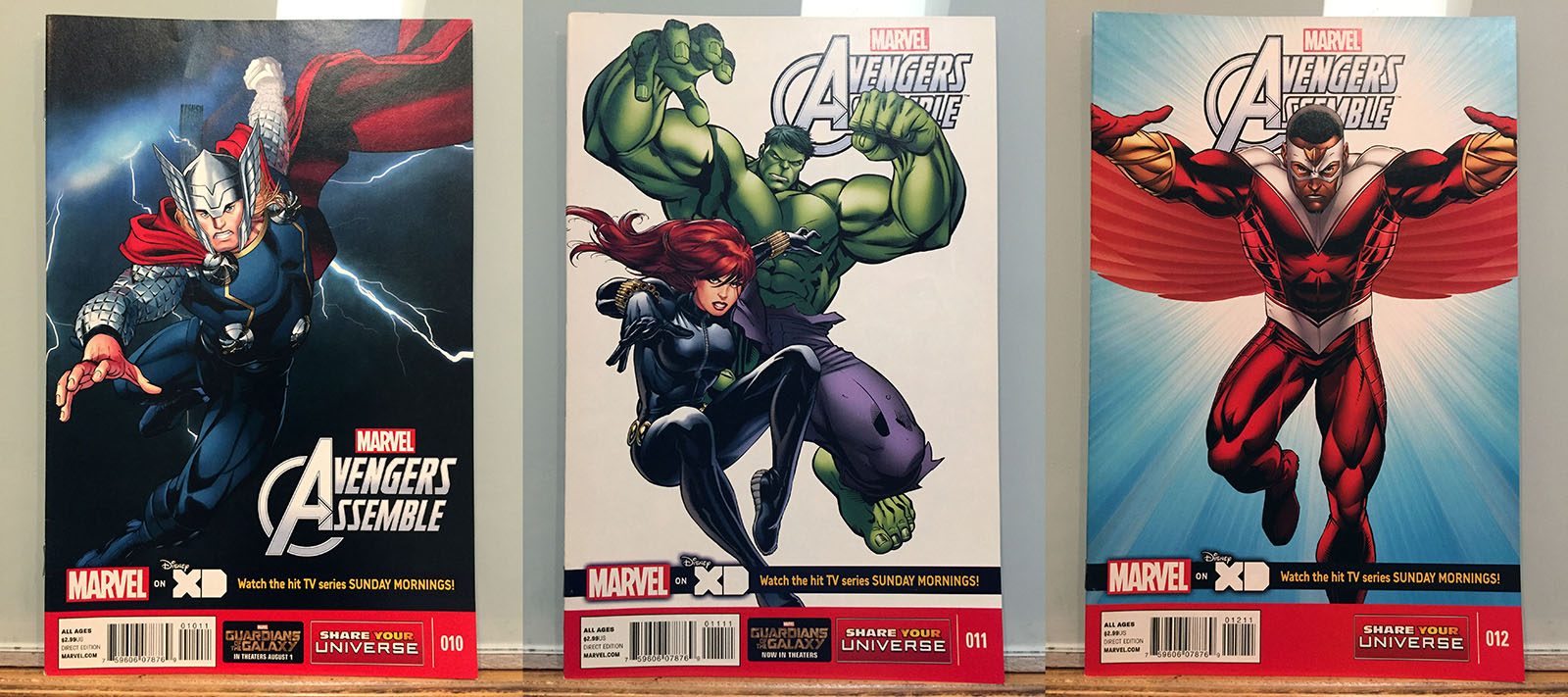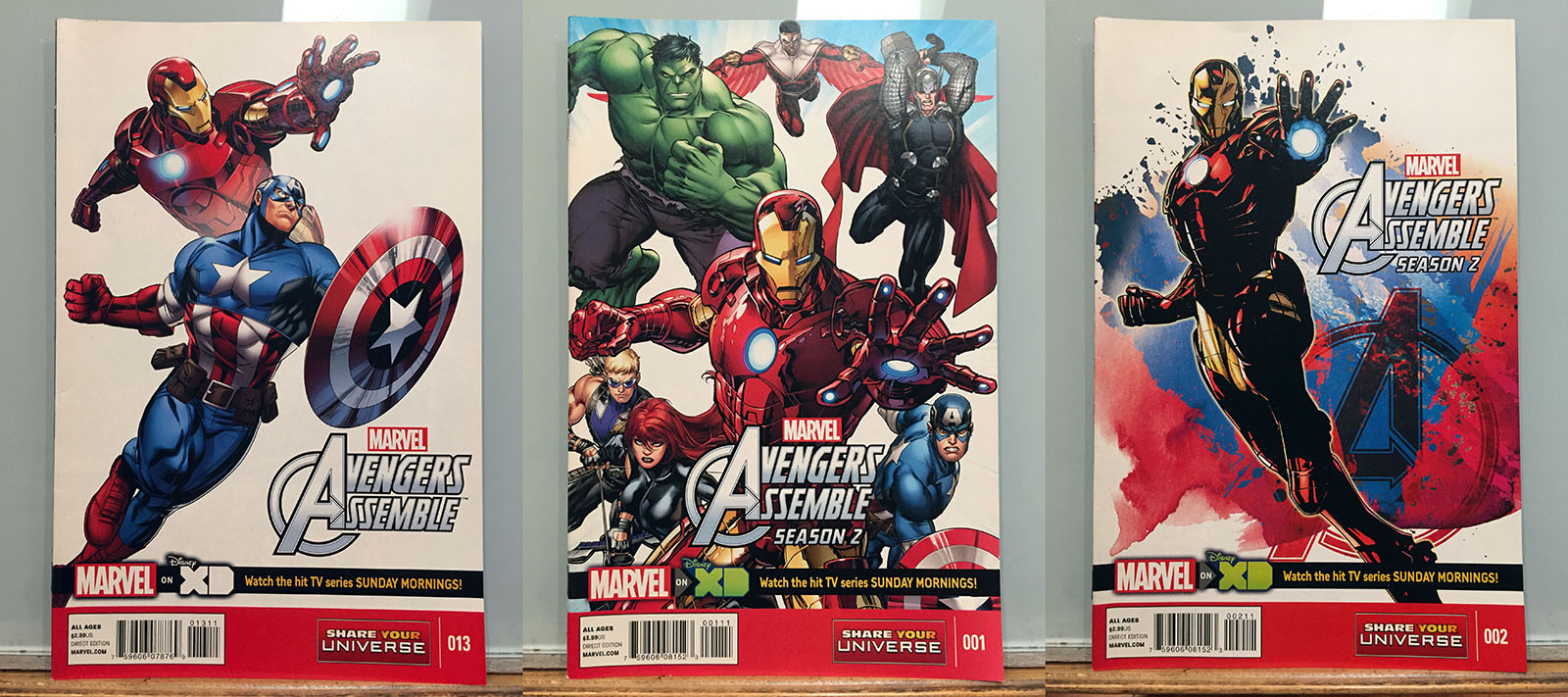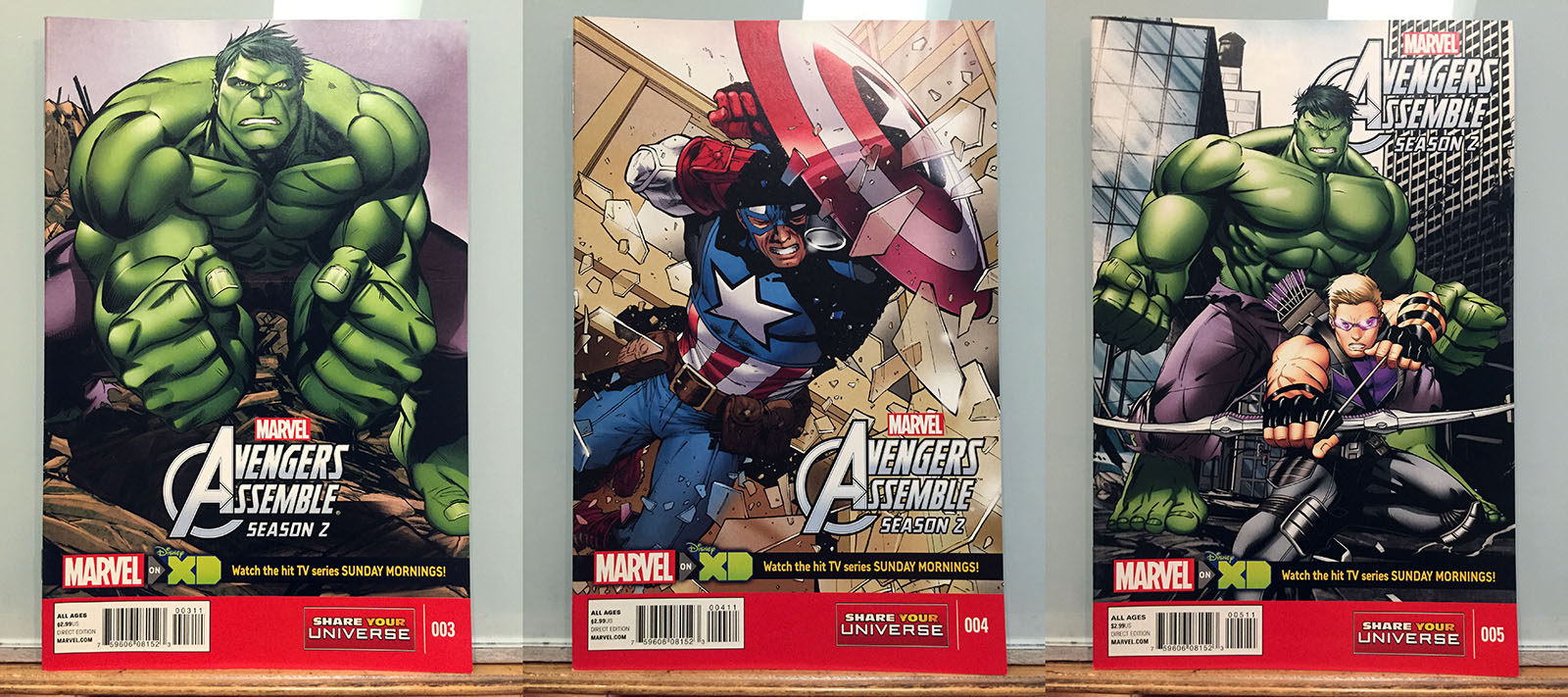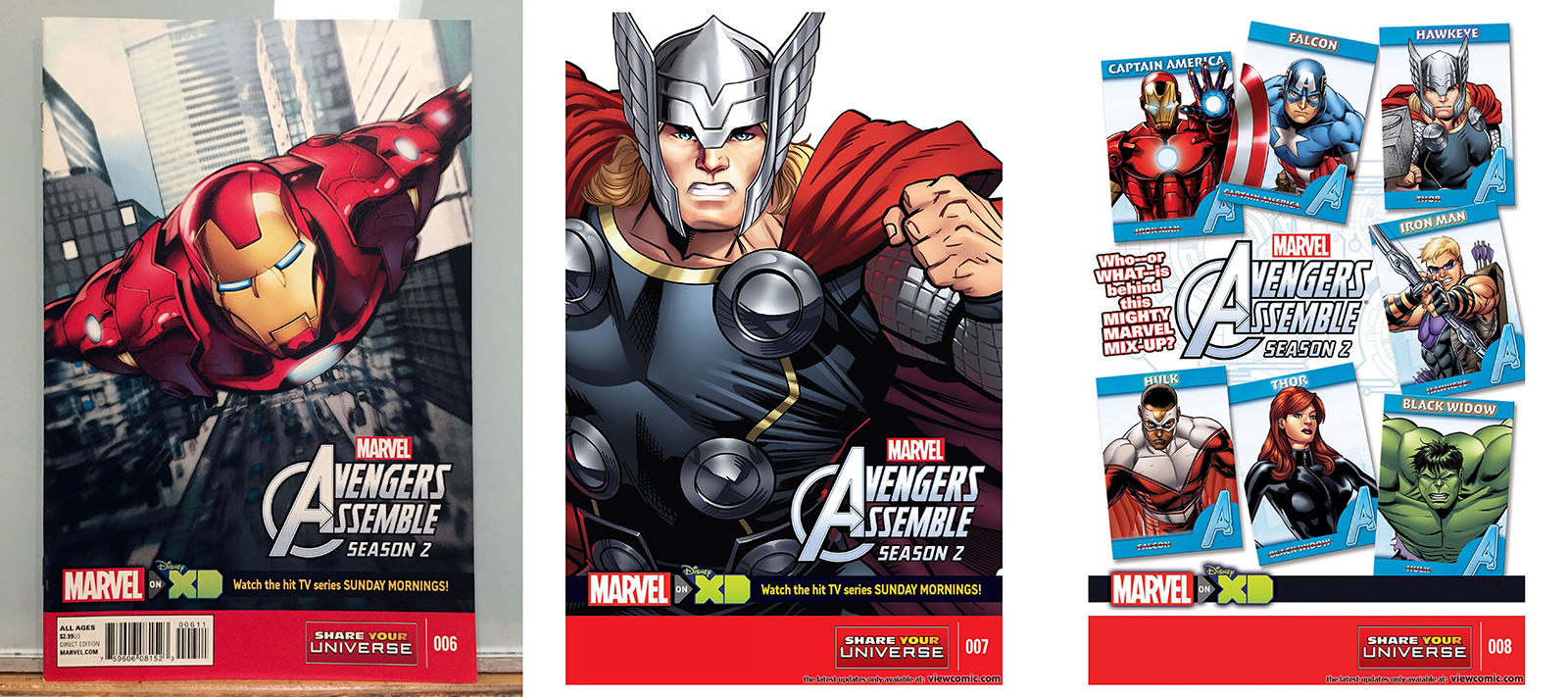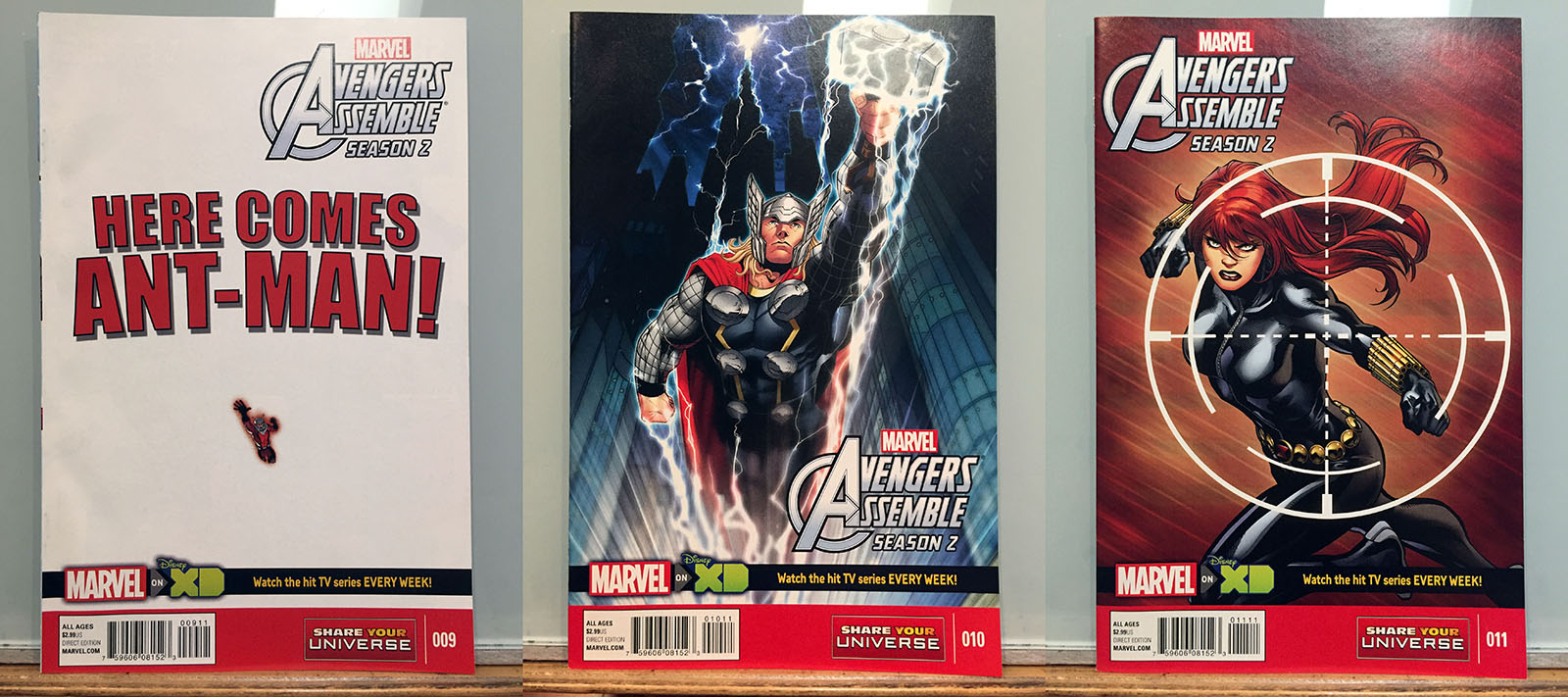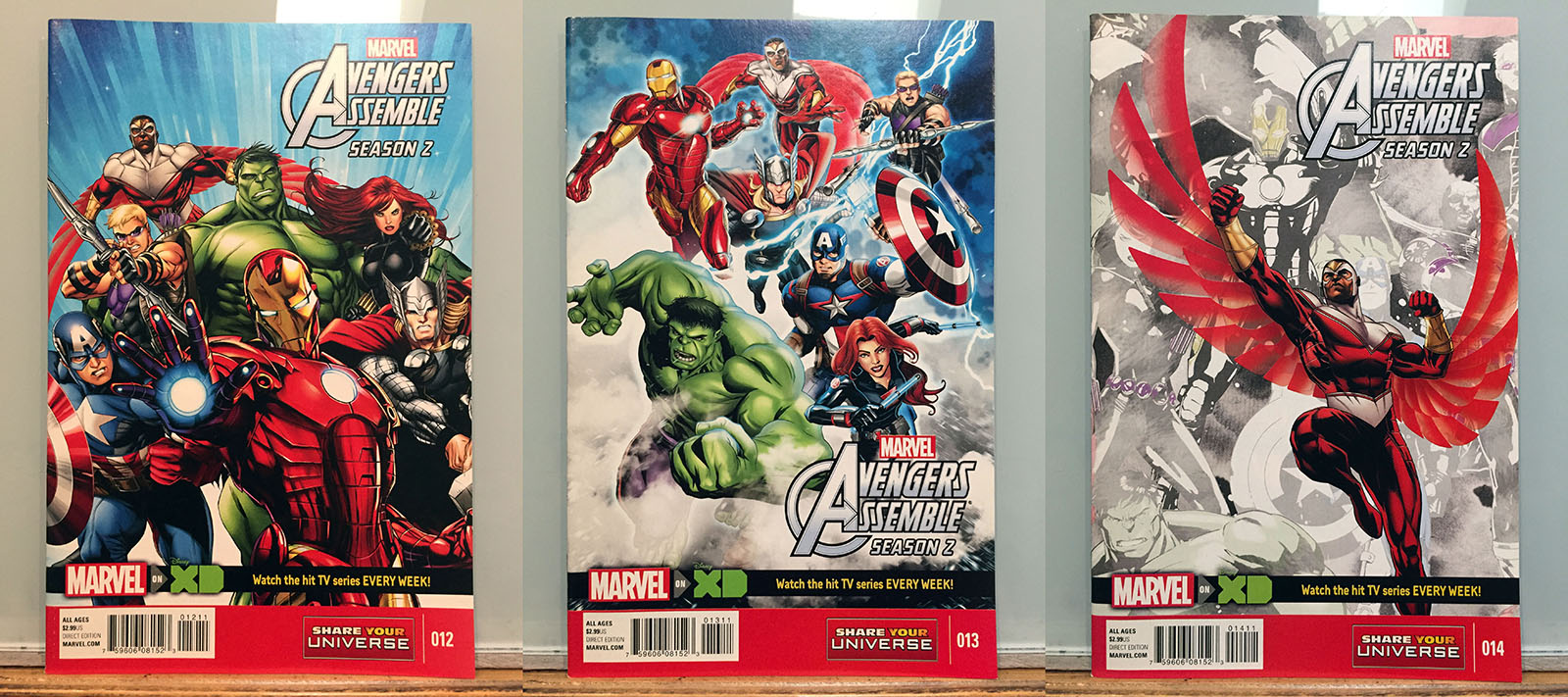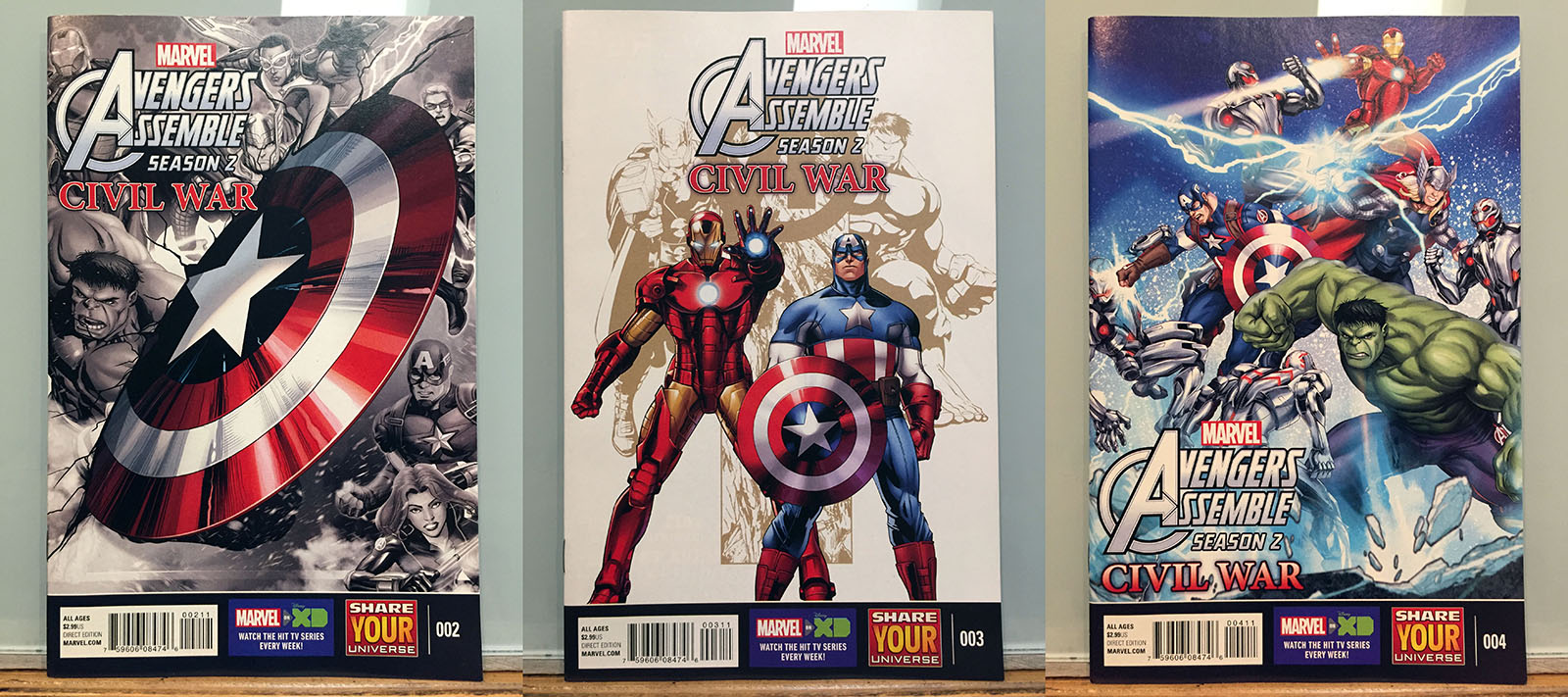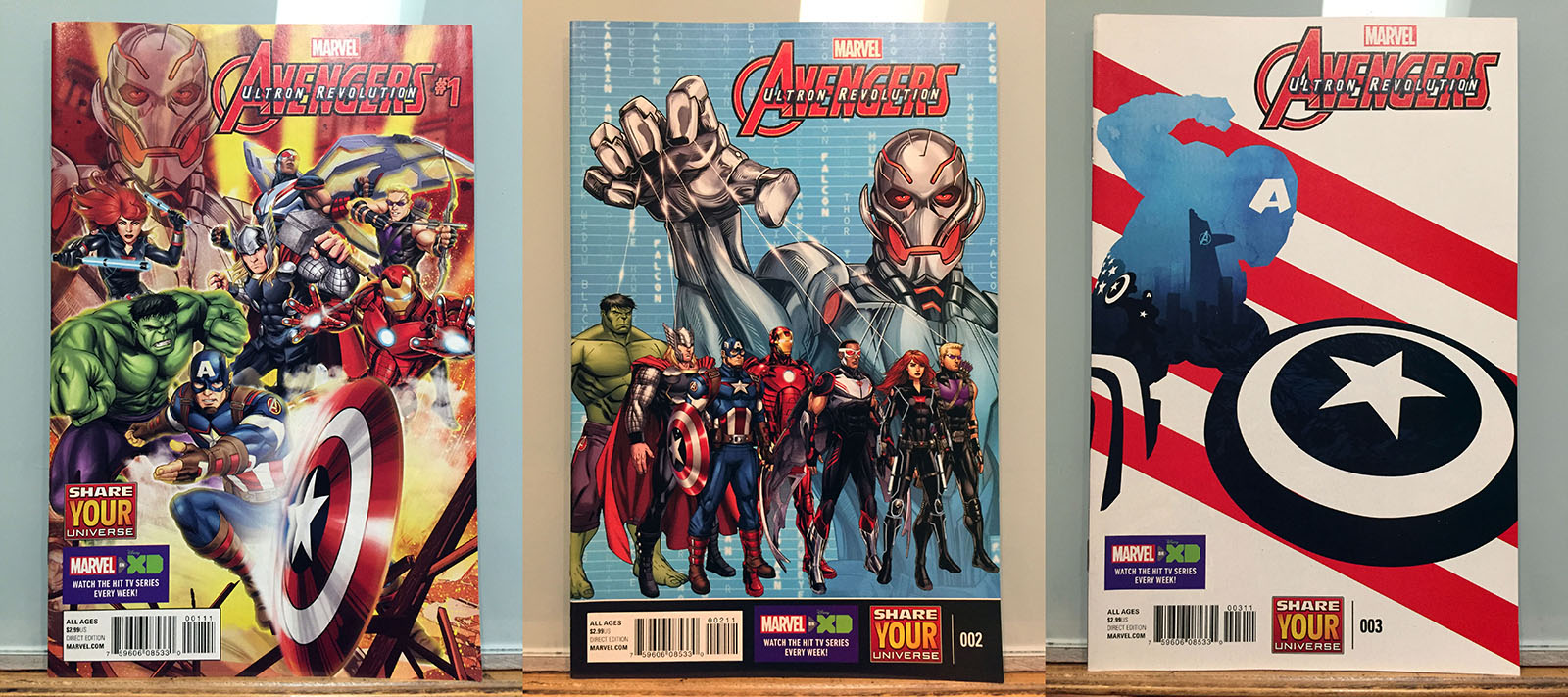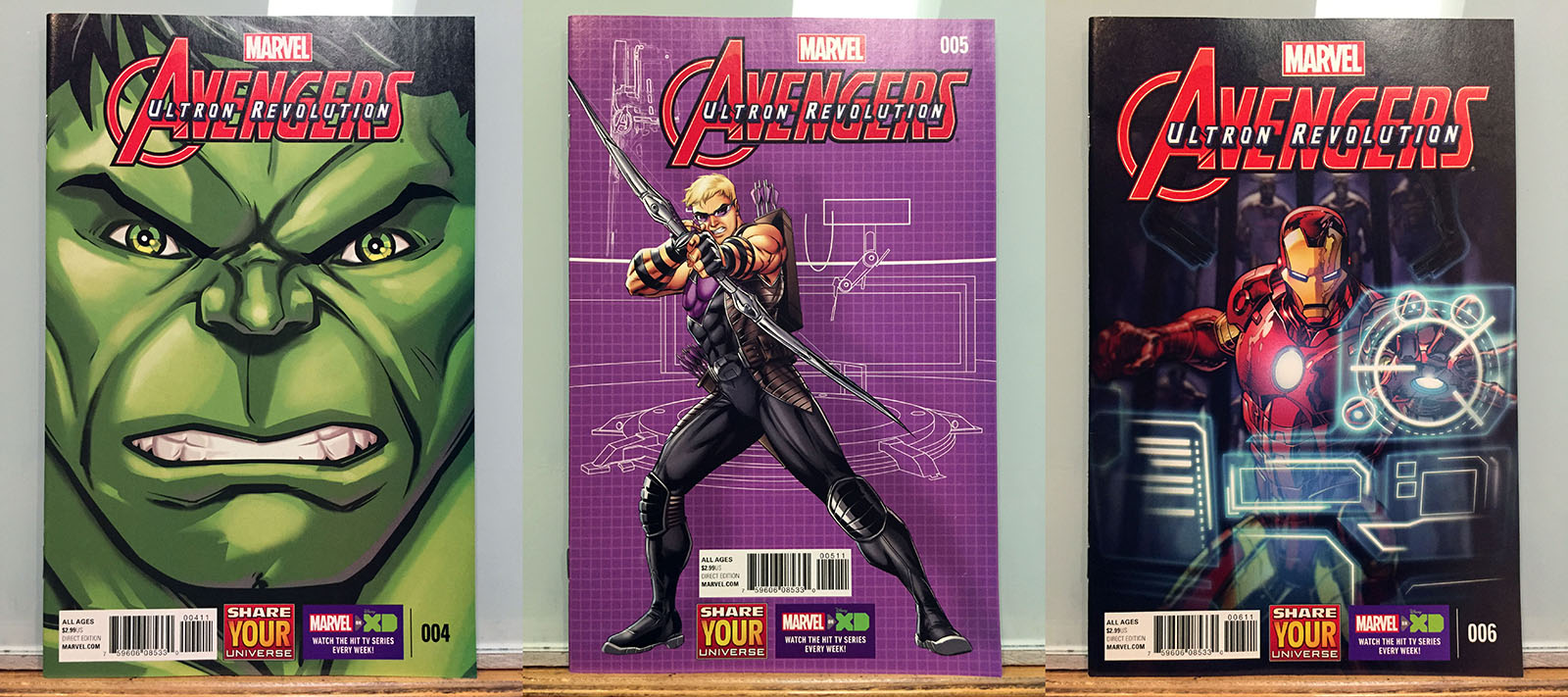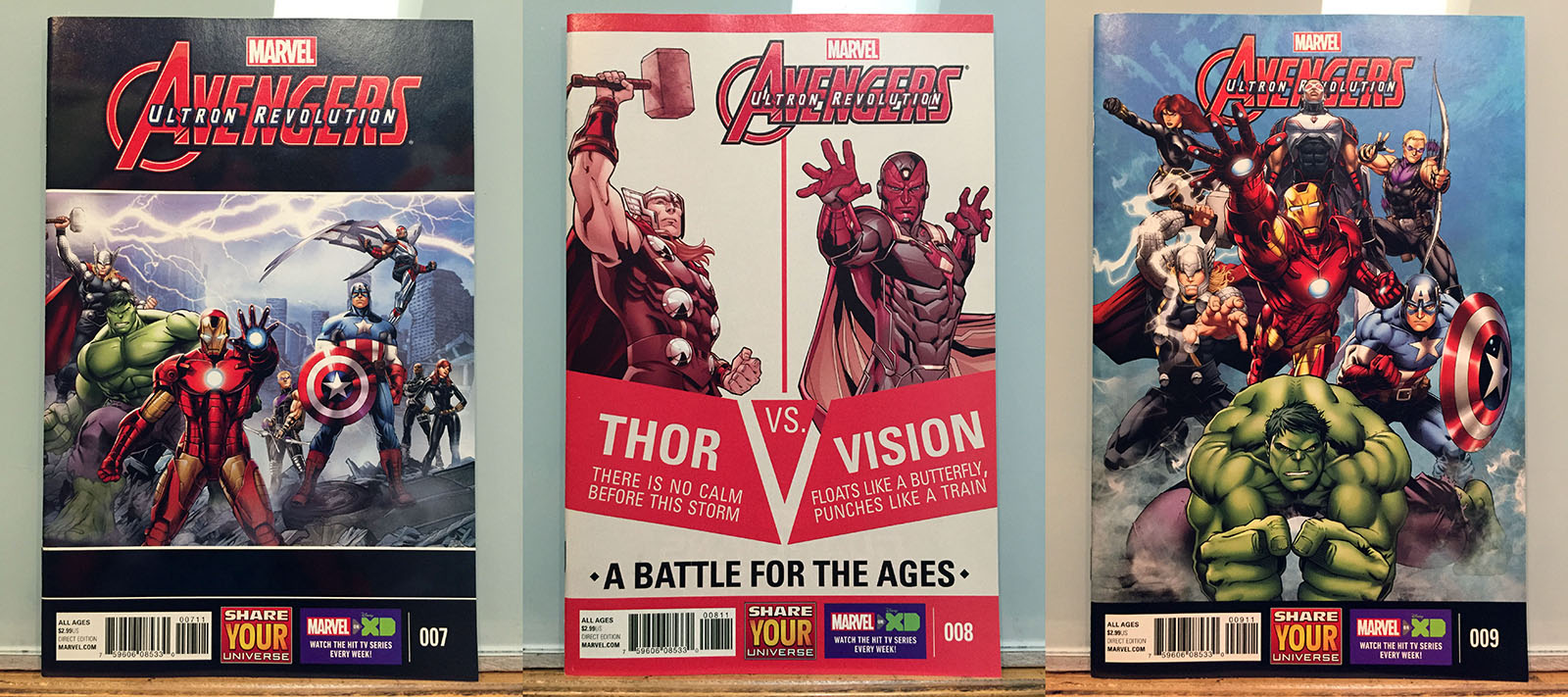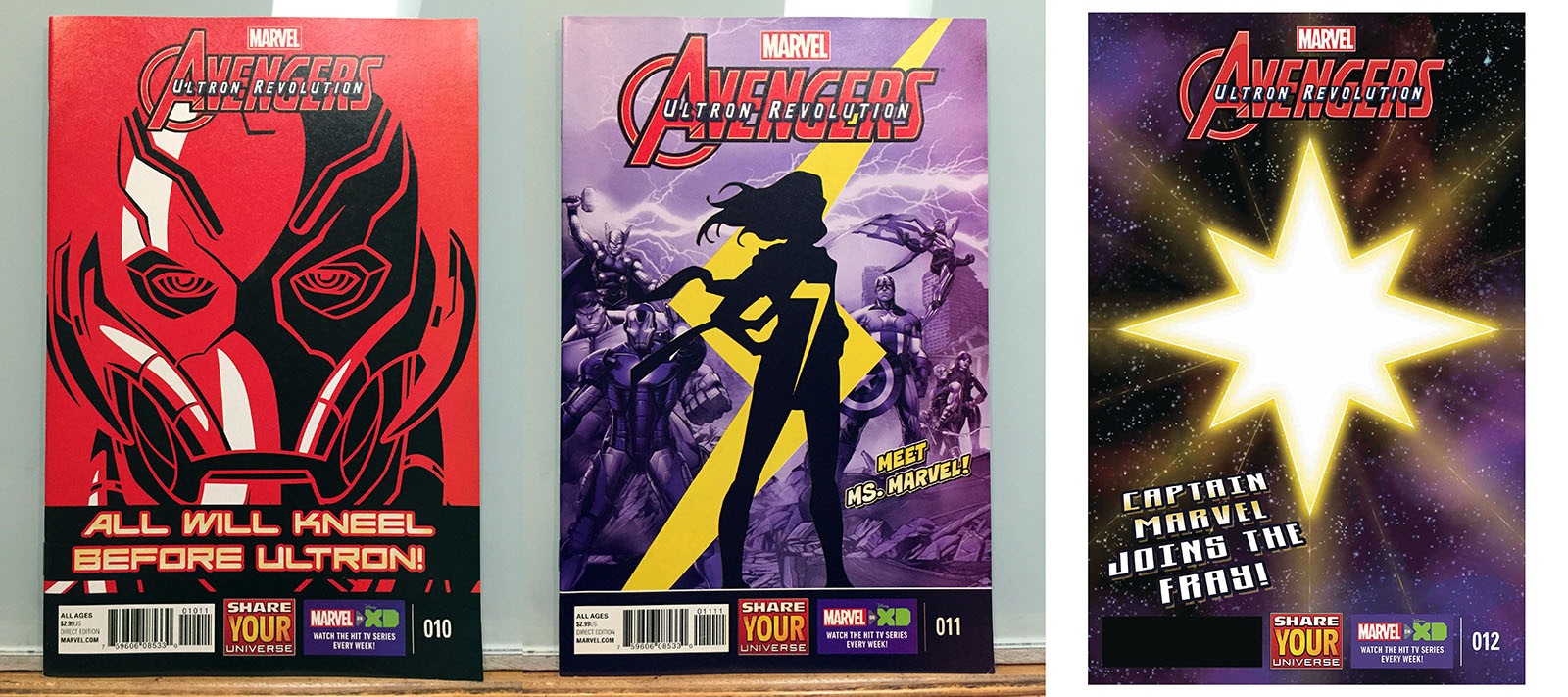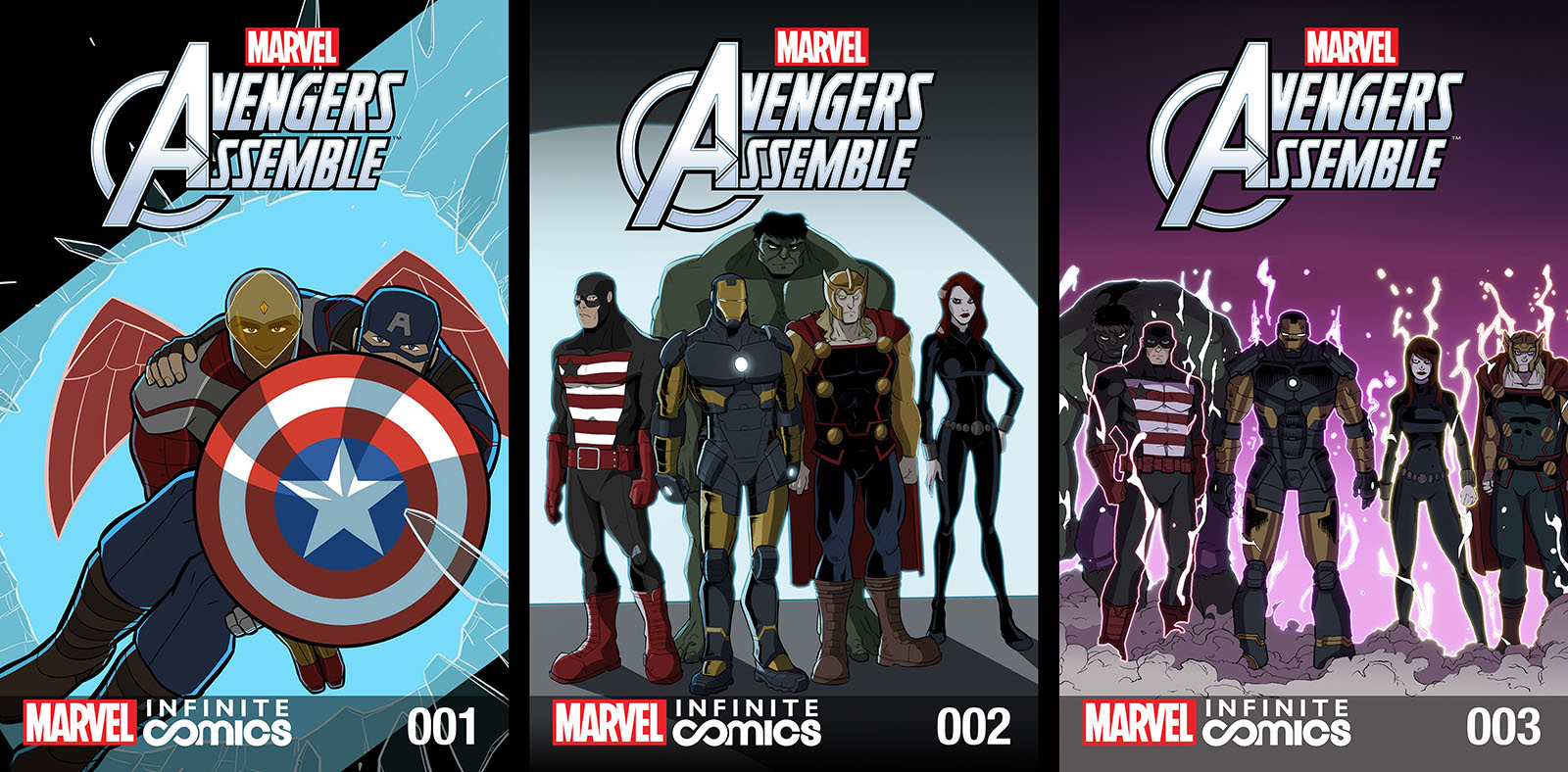Avengers Assemble Season 3, 2015-16
Avengers Assemble was simultaneously the hardest and most rewarding series I’ve yet worked on. There was a new challenge in every episode, and I wrestled it to the ground every time with the help of my storyboard team. This was our third year working together, me in L.A. and them in Vancouver. Our first two seasons were battles of attrition in which artists who weren’t a good fit for the show were gradually replaced by those who were. By this time, we were so battle-hardened that you could have stubbed out cigarettes on us and we wouldn’t even feel it.
We needed ALL that fighting spirit to face the challenges of Ultron Revolution. The MCU was moving through phase 2 and the push on our side (as a support mechanism) was to feature as many new heroes and villains as possible. While this season was in production, the MCU films released were Age of Ultron and Ant-Man. Both Ultron and Ant-Man had appeared in our second season (which was airing at the time), and now they were back for more. It was already known that Civil War and Doctor Strange would come out while season 3 was broadcast, so both were entwined in interesting ways. A little planning can go a long way.
I directed all the even-numbered episodes in this season of 26. Right from the start, directing the evens sets you up to do the grand finale. After seasons 1 and 2, I knew I was in for something big, and I was not wrong. The odd-numbered episodes were directed by Phil Pignotti, who jumped over to the newest Spider-Man series at the midpoint. Storyboard wiz Micah Gunnell was promoted to replace him for the second half, which gave me a new roommate to commiserate with.
The best part of it all was seeing new characters for the first time. Over the course of this season, we got Captain Marvel, the Inhumans, Ms. Marvel, the Masters of Evil, the Thunderbolts, SteelCorps, the U-Foes, a whole second team of Avengers, Kang the Conqueror, Doctor Strange, Black Panther, and more. I had the pleasure of not only drawing a lot of them in their introductory episodes, but designing a lot of sets and props to accompany them.
The Inhumans were the biggest new component of the season. Knowing they were coming up, I started devouring Inhumans comics old and new. It was known that they would be the subject of an MCU project, and I strongly suspected they would get their own animated series at some point. It felt like a chance to lay down some important groundwork, so I single-handedly designed all of Attilan for their premiere episode and worked out ways to stage their powers as they continued to appear. What I didn’t know, unfortunately, was that there was considerable ambivalence about the Inhumans in certain factions of the MCU (find out more here). When they demoted a movie to a poorly-executed 2017 TV series, it clobbered any chance of a cartoon. Despite this unfortunate outcome, I enjoyed every minute of the work.
The presence of the Inhumans gave us our own version of Civil War in which, rather than superhero registration, the point of contention was Inhuman registration. It boiled over to such a degree that the first Avengers team quit and a second was formed to uphold the law. This led to a team clash (which I got to direct) and a global conflict in which both teams AND the Inhumans fought an army of Ultron robots (which I also got to direct). It was a massive undertaking with more characters than I’d ever seen in a single cartoon.
There were still two more seasons to come, but nothing would top that one. It was absolutely glorious, and I never, ever want to do it again.
Looking back at how dense and busy these shows were, it’s astonishing that we could be handed a new script every four weeks and still keep all the trains on the track. I directed 13 over a period of about 14 months. At that pace, there are three phases: in phase 1 you’re adding new scripts to the workload while previous ones are still in production. In phase 2, you reach peak productivity with five episodes all in different stages simultaneously. This lasts for three to four months. Then in phase 3, you begin peeling finished shows off the pile until you get down to the last one.
As far as I can tell, that production model doesn’t exist any more. Or if it does, it’s very rare. Most things I’ve worked on after Avengers went to only 10 or 13 episodes with a new script every six weeks. The workload is more humane, but the overall duration is shorter. I have no idea what the production landscape will look like a few years from now. It all depends on how many studios think cartoons are still worth making.
Avengers Assemble season 3 ran for 26 episodes. Storyboards were produced from January 2015 to February 2016. The season aired on Disney XD (with a few breaks) from March 2016 to January 2017. It can now be seen on Vudu, Amazon Prime and Disney Plus.
Wikipedia series page | Wikipedia episode page | Season 3 page at fandom.com
Episodes I directed
2. The Ultimates
Ultron returns and plans to replace humanity with robots, starting with duplicates of the Avengers known as Ultimates. Each one is as difficult to defeat as the Avenger it is modeled upon.
Right off the bat, we had a huge team-on-team episode to contend with, which is always an exercise in implying more than you’re seeing to keep it animation-friendly. I got to design the drone robots in the training room sequence, and a hybrid Iron Man pieced together from the many armors we created for earlier shows.
Trivia: as this episode was being storyboarded, we all saw the Age of Ultron trailer for the first time, and that very day I swiped the Cap-throwing-his-motorcycle gag for a chase scene. After that, I had Cap throw motorcycles at every opportunity.
4. Under Siege
While the Avengers are away on an investigation, Hawkeye is left to defend Avengers Tower alone against Baron Zemo and his new Masters of Evil until they can return to face off against these new foes.
Second episode, second team-on-team battle. But for a large part of this one, it was Hawkeye on his own doing cool Hawkeye things in our own version of Die Hard. My drone robot got used again (reusing designs is always a good time and money saver) and I came up with various effects for new super-powers.
6. Thunderbolts Revealed
A new team of heroes called the Thunderbolts arouses suspicion. Hawkeye discovers that they are actually the Masters of Evil. When Baron Zemo’s true motives are revealed, the Thunderbolts must decide whether they should help the Avengers stop him.
This made it a hat trick with THREE team-on-team episodes in a row. And since the Thunderbolts were another team in disguise, this one was a team-on-two-team version. There were also three versions of the hypersonic villain Klaue/Klaw, which made this show a real tour de force in effects design.
8. DeHulked
Bruce Banner’s old lab assistant Igor Drenkov leads the SteelCorps to use a gamma-draining weapon on Hulk, turning him back into Bruce Banner. Drenkov plans to use the stolen gamma energy to become the hero he always wanted to be.
SteelCorps is a gang of soldiers in powered armor, which is one of my jams. I designed our version based on comic reference and an action figure, and also developed all the sets and props in the latter part of the episode. If you wonder why I keep bringing up my design work for the series, it’s because that’s where I had the most fun. You can find my design catalogs in the articles for seasons 1 and 2.
10. The Inhuman Condition
Lockjaw brings the Avengers to Attilan to help free the Inhuman Royal Family. There, Ultron plots to use Black Bolt as a power source for a new super weapon that will destroy the human race. The Avengers succeed, but a massive cloud of terrigen blankets the Earth to create new Inhumans.
There was no show this season that I didn’t enjoy working on, but this one stood above all the rest. It was the “magic episode” where I could see it all in my head when I read the script and the rest of the job was to capture what I saw. Plus, I designed pretty much everything in it, which is about as much as one director can accomplish.
Trivia: Kamala Khan makes her first-ever animated appearance in this show as we witness her origin (as told in the comics long before it was rewritten for live action). She became Ms. Marvel in the next episode, which I did not direct.
12. The Conqueror
The Avengers try to stop A.I.M. from stealing high-tech weapons from the future. Their fight attracts the attention of the 30th-century warlord Kang the Conqueror, since it was his technology being stolen.
Another doozy with a lot of design opportunities. This time I came up with Kang’s ship (inside and out) and all his weird, futuristic gadgets. I also gave him a specific acting style based on extreme arrogance, where he refuses to make eye contact while speaking to you – until you make him angry, which means you got in his head. And that makes him even more angry.
14. Seeing Double
When Hulk is captured by Hydra Agents, Black Widow, Captain America and Iron Man trail them to Siberia where Baron Strucker has not only revived the Red Room program, he also uses the Winter Soldier program to turn Hulk into the Winter Hulk.
This was a fantastic episode all around; if not for the Inhumans show, it would have been my favorite of the season. Not just for the design work I got to do, but for the staging and fight choreography we all put into the storyboard. Everybody brought their A game to this one.
16. Captain Marvel
Captain America, Thor, and Falcon join Captain Marvel to fight Kree soldiers rounding up recently-emerged Inhumans. This leads to a battle in space in which the Kree launch a deadly missile attack on Earth.
I just kept winning the lottery with this season. I’d always liked Captain Marvel, so it was an honor to introduce her to our series. She’s a space hero, so there were spaceships for me to design and a space battle to choreograph. Basically, it was an episode written for me to direct and I enjoyed every minute.
18. Ant-Man Makes it Big
On the set of a superhero movie, Hawkeye and Black Widow team up with Ant-Man to stop the disgruntled Egghead from destroying Los Angeles with robots. Meanwhile, Thor takes the actor portraying him on a journey to see what it’s really like to be Thor.
This was a nice break from the hyper-serious tone of the season; a semi-comedic Hollywood episode with real L.A. backgrounds and a ton of design work by me to create all the studio sets and Egghead’s Eggbots. Plus, we created a parody trailer for the movie being made in the episode.
Trivia: the guy on the phone was Eric Radomski, our boss at Marvel Animation Studio. The biker gang was made up of my co-workers.
20. U-Foes
The Avengers are ordered to enforce the New Powers Act to register emerging Inhumans. Meanwhile, Hydra scientists fly into space and are transformed into the U-Foes, after which they take over Hydra and hijack a SHIELD helicarrier. In the wake of the battle, Hulk leaves the Avengers to be replaced by Red Hulk.
Back to the team-on-team dynamic, we introduced the U-Foes, who I’d never actually heard of. But when I learned that they were conceived as “the Fantastic Four, but evil,” I found my way in. This wasn’t my favorite script of the season, but we always succeeded in making them better in the storyboard.
22. World War Hulk
The Leader has turned Red Hulk into his “ultimate weapon,” and the Avengers must stop his rampage. After they fight to a standstill, Hulk powers up to step in, but now he may be an even bigger threat!
This was basically a brawl episode with Red Hulk vs. everyone. I wouldn’t have wanted to be on the animation team for this. Each of the Avengers (except Thor) got their own customized Hulkbuster armor, and its design wasn’t simplified AT ALL from the movie version. It must have been murder to animate. (We did learn later that Avengers was one of the hardest shows being animated in Korea at the time, second only to Guardians of the Galaxy.)
24. Civil War Part 2: The Mighty Avengers
The team quits rather than enforce the New Powers act, refusing to help round up Inhumans. Their former boss Truman Marsh forms a new team called The Mighty Avengers, and both teams clash over a trio of fugitive teenage Inhumans.
This is where our 4-part take on Civil War erupted into a true epic that would take the season to its climax. Every member of the new Avengers team had been introduced in earlier episodes, but this was the first time I got to draw some of them. It would not be the last. After reading Ms. Marvel comics from the first issue, I especially enjoyed getting her into the action.
26. Civil War Part 4: Avengers Revolution
Truman Marsh has been unmasked as Ultron in disguise, and has mind-controlled all the Inhumans into becoming his personal army. Both teams of Avengers team up with Doctor Strange to turn the tide in a battle royale that spans the globe.
No single super hero cartoon ever has and ever COULD deliver more than this one did: 14 Avengers and another half-dozen Inhumans battling multiple robot armies, culminating in an everyone-vs-Ultron showdown in the giant dish of the Aricebo radio telescope (before its tragic demise in 2020). The only way you make such an episode practical is by carefully dividing up your characters so you’re always showing as few as possible while still implying more. That task became harder than ever with a cast this large.
Doctor Strange had appeared a few times before, but this was the first episode where I got a crack at him. The finale took place in another dimension which pulled heavily from Steve Ditko style. Strange’s first movie was in production at the time, but since we had no reference for it, our version didn’t look very much like it. That was unfortunate, since the episode didn’t air until after the movie had come and gone.
The Comics
One fine Wednesday in January 2014, I strolled into my local comics store and was delighted to see a new Marvel series devoted to our show. I was even more delighted to open it up and see what we used to call a “photonovel,” stills from the show itself arranged into a comic book format with word balloons and all. Back in 1993, I pitched this idea to the editors at Malibu Comics when I worked there, but image-capturing technology wasn’t quite up to the task yet. With the advent of HD, it finally became possible.
Side note: before home video came along, “photonovels” were a dream come true. I still have my copies of Alien and Outland, and they’re phenomenal. But despite my daily prayers for Star Wars versions, they never appeared. That’s how I know there is no God.
Since the comics were monthly, they did not keep pace with the TV series and they didn’t cover every episode. But 45 issues is nothing to sneeze at. I noticed that the scriptwriters were credited in the “season 1” comics, but the directors were not. Since we decide what you actually see in a show, I thought we should get a nod. I suggested this to our head of production, who passed it on to the publishing side. Starting with the “season 2” comics, there we were. Getting my name on TV is great, but getting a credit in a Marvel comic book was a childhood wish come true.
Below are all the issues with links to read them for free. Digital copies can also be found on Marvel Unlimited under the search term Marvel Universe Avengers Assemble.
Read it here
Read it here
Read it here
Read it here
Read it here
(not found)
(not found)
(not found)
(not found)
(not found)
(not found)
(not found)
(not found)
Read it here
Read it here
Read it here
Read it here
Read it here
Read it here
Read it here
Read it here
Read it here
Read it here
Read it here
Read it here
Read it here
Read it here
Read it here
Read it here
Read it here
Read it here
Read it here
Read it here
Read it here
Read it here
Read it here
Read it here
Read it here
Read it here
Read it here
Read it here
Read it here
Read it here
Read it here
Read it here
In addition to all of these, there was a spinoff comic titled Avengers Assemble Infinite Comics that ran ten issues. Read them all for free here.

